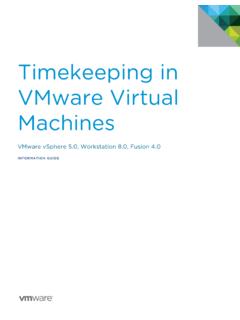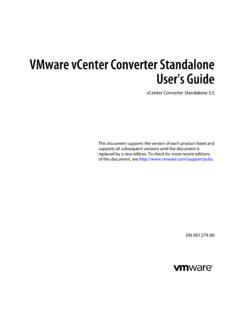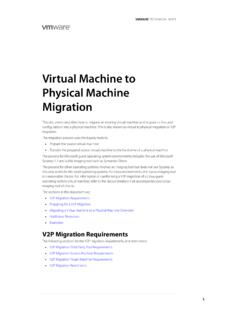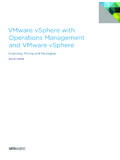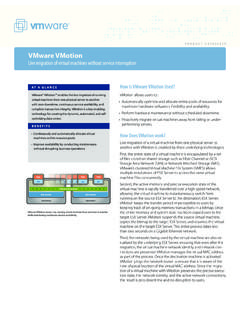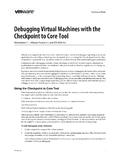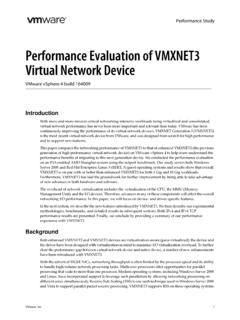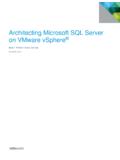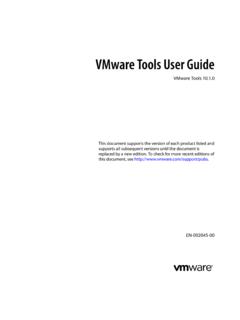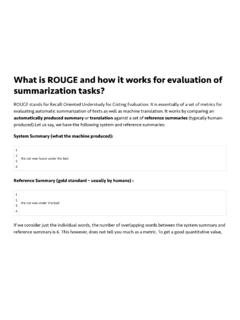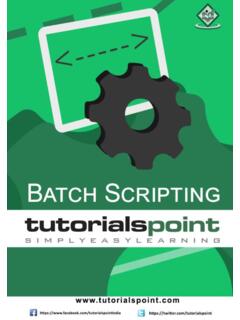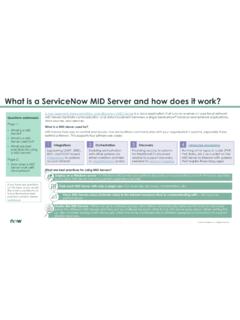Transcription of Managing VMware VirtualCenter Roles and Permissions
1 Managing VMware VirtualCenter Roles and PermissionsB E S T P R A C T I C E S V M wa r e B E S T P R A C T I C E STable of ContentsIntroduction ..3 VirtualCenter Objects and Permissions ..3 Built-in and Custom Roles ..4 Task-based Privilege assignment ..6 Creating a Virtual Machine ..6 Inventory Manipulation ..7 Networking, Storage, and Host Maintenance ..7 Creating Custom Roles ..8 example : allowing Template Deployment to a resource Pool ..8 example : Network administrator ..9 example : VMware Consolidated Backup User ..10recommendations for VirtualCenter Roles ..10appendix: Perl Script for Listing all role assignments ..12about the author ..14 V M wa r e B E S T P R A C T I C E SIntroductionOne key management task in a VMware Infrastructure environ-ment is determining who can use VMware VirtualCenter and what tasks those users are authorized to perform.
2 The person who has the role of administrator for the system is authorized to assign the rights needed by other users. Generally, only a limited set of people should be given the administrator role. If you are the administrator, you should then use VirtualCenter Roles , described in the sections that follow, to delegate manage-ment of ESX Server hosts and virtual machines to others. This paper introduces you to the way Virtual Infrastructure controls access to resources and describes techniques you can use to assign appropriate access rights efficiently. It explains the concept of Roles , provides information to help in the design of custom Roles , and gives recommendations for how to work with Roles and privileges in Objects and PermissionsThe authorization to perform tasks in VMware Infrastructure is governed by an access control system.
3 This system allows the VirtualCenter administrator using the Virtual Infrastructure Client to specify in great detail which users or groups can perform which tasks on which objects. It is defined using three key concepts: Privilege The ability to perform a specific action or read a specific property. Examples include powering on a virtual machine and creating an alarm. Role A collection of privileges. Roles provide a way to aggregate all the individual privileges that are required to perform a higher-level task, such as administer a virtual machine. Object An entity upon which actions are performed. VirtualCenter objects are datacenters, folders, resource pools, clusters, hosts, and virtual machines.
4 Figure 1 shows the hierarchy of objects you can manage in the Virtual Infrastructure addition, VirtualCenter depends upon the users and groups defined in your Active Directory environment or on the local Windows server on which VirtualCenter runs. One key point to note is that an ESX Server host can have its own set of users Managing VMware VirtualCenter Roles and Permissionsand groups that is independent of the Active Directory users and groups. If you are using VirtualCenter , you should avoid defining any users on the ESX Server host beyond those that are created by default. This approach provides better manage-ability, because there is no need to synchronize the two lists if a user or group is added or updated on one of the systems.
5 It also improves security, because it makes it possible for all permis-sions to be managed in one place. For a full description of the way ESX Server and Virtual Infrastructure Client recognize and manage users and groups, see the sections Users and Groups in Chapter 15 of the manual Basic System Administration in your VMware Infrastructure shows the relationship between Roles , objects, and users. Together they define a permission. The role defines the actions that can be performed. Users and group indicate who can perform the action, and the object is the target of the action. Each combination of user or group, role, and object must be specified. In other words, the administrator first selects an object from the overall VirtualCenter inventory, then selects root folderfolderfolderfolderfolderfolderfold erfoldertemplatetemplatetemplatenetworkn etworknetworkdatastoredatastoredatastore VMVMVMVMVMVMVMVMVM clusterclusterhosthosthosthostresource poolresource poolresource pooldatacenterdatacenterdatacenterdatace nterdatacenterfolderfolderdatacenterdata centerHosts and ClustersVirtual Machines and TemplatesNetworksDatastoresFigure 1 The Virtual Infrastructure Client object hierarchy V M wa r e B E S T P R A C T I C E Sa role to be assigned to that object, then selects the user or group to which this permission pertains.
6 For detailed instruc-tions, see the section Assigning Access Permissions in chapter 15 of the Basic System Administration are more than 100 privileges, which roughly correspond to individual actions a VirtualCenter user can take. They are grouped hierarchically in the Virtual Infrastructure Client for convenience. Appendix A of the manual Basic System Administration in your VMware Infrastructure documentation describes all of the each permission, you can decide whether the permission propagates down the object hierarchy to all subobjects, or if it applies only to that immediate object. For example , you can have a role called Datacenter Administrator, which gives a user privileges to manage hosts, network, and datastores, but then choose for that role not to grant that user administrative privi-leges for virtual machines on those hosts.
7 In a contrasting case, you can grant a user very limited Permissions (for example , read-only) from the datacenter level on downward, then grant more permissive Roles on certain subobjects, for example , a folder of virtual machines. In addition to specifying whether Permissions generally propa-gate downward, you can override Permissions set at a higher level by explicitly setting different Permissions for a lower-level object. For example , you might give a user read-only permis-sion at the datacenter level and administrator permission for a particular folder. If you set the administrator permission to propagate, that permission also applies to all branches below that particular folder. If you set the administrator permission but do not set it to propagate, the user has no rights at all on branches below that particular folder not even : There is a known issue in VirtualCenter .
8 And lower that causes a misleading display indicating read-only per-mission at lower levels even when propagation is not set. This issue affects only the display in the user interface. The actual Permissions are set as described in this normal process of setting up users, groups, and Permissions can grant a user differing Permissions on the same object. This can happen easily if, for example , the user belongs to two differ-ent groups and the two groups have different Permissions on the object. In this case, the user is granted Permissions that are a union of the groups Permissions . For example , if one group is allowed to power on virtual machines and the other is allowed to take snapshots, then a user who is a member of both groups can do both.
9 If an individual user has an explicit permission set on the object, however, this individual permission overrides all implied group Permissions . For example , if a role that does not permit powering on virtual machines or taking snapshots is granted to a user explicitly on that object, the user cannot perform either and Custom rolesVirtualCenter and ESX Server hosts provide default Roles : System Roles System Roles are permanent and the privileges associated with these Roles cannot be changed. The three system Roles are: No Access, Read-Only, and Administrator. The latter two also exist in VirtualCenter Sample Roles Sample Roles are provided for convenience as guidelines and suggestions.
10 Table 1 lists the sample Roles in VirtualCenter .x. Note that two of these Roles are meant to emulate the Roles with the same names in VirtualCenter Administrator role is the most powerful one in VirtualCenter . It essentially allows the user to perform every available action in VirtualCenter . You should grant this role to as few users as possible. The Read-Only role allows the user to view the state and configuration of objects without modify-ing them. The No Access role prevents a user from seeing any objects. It is equivalent to assigning no role to a user for a par-ticular object. The No Access role is useful in conjunction with other Roles to limit their scope, as shown in an example later in this built-in Roles provide a way to get started with VirtualCenter Permissions management.

